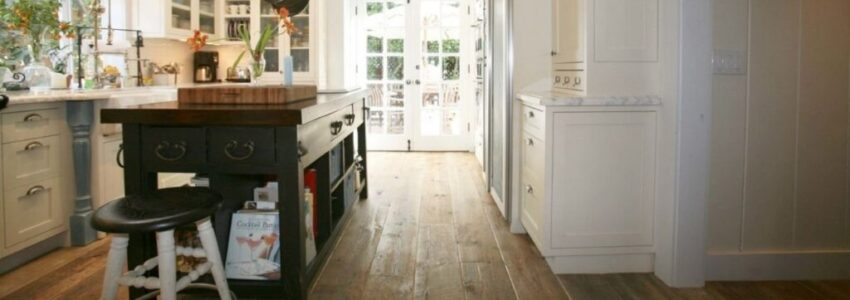What NOT To Do When Bleaching Wood Floors
- Get link
- X
- Other Apps
What NOT To Do When Bleaching Wood Floors

Originally Published on usvintagewood.com
Wooden floors look nice when they’re new. But over the years, all kinds of stuff gets poured onto your floor – from water to cola and even urine. This causes dark and unsightly stains to tamper with what once was pristine wood. Hence, the need for bleaching.
In general, bleaching wood floors are easy to DIY. And in case you’re wondering, yes, it’s safe to apply bleach on wood. Unless it’s exotic wood like Brazilian cherry and mahogany. However, you’ll be working with harsh chemicals like oxalic acid and chlorine. If you’re not careful, you could end up with burns and scalds. So if you’re planning to bleach your wooden floor, here are some cautionary advice for you:
1. Don’t Forget to Remove Protective Sealants
To effectively bleach any wooden structure, the bleach must penetrate the wood. But if there are still protective sealants left on the wood’s surface, you’ll just be wasting money. The sealant prevents the bleach from reaching the wood’s surface. So no matter how many times you apply that bleach, it won’t work.
Depending on what kind of sealant is protecting the wood, you can sand it or apply some thinner or chemical stripper. If you’re sanding the wood, don’t forget to clean it thoroughly after.
Just a little disclaimer though. If you’re working with antique wood, you’ll probably want to think this through. Removing protective sealants from vintage woods usually causes a decline in their value.
Also, if you’re working with engineered hardwood, make sure the veneer is thick enough to be sanded. Otherwise, you’ll risk destroying your floor.
2. Don’t Forget To Do Some Research
Removing stains from wood may require a different process than if you’re trying to lighten or darken your wooden floor. Plus, each type of stain needs different types of bleaching agents. If you’re trying to get rid of water damage and common stains like tea or juices, your regular household bleach should do the trick. But you may need to use harsher chemicals like oxalic acid if you’re trying to get rid of stubborn iron or urine stains. Oxalic acid is also good for removing hardwood floor stains.
Achieving a specific color also requires different sets of chemicals. For instance, you can use a mixture of hydrogen peroxide and sodium hydroxide (caustic soda) if you want to change the natural color of the wood. But if you’re trying to adjust the stain color, you may need to use dilute sodium hypochlorite or just plain chlorine bleach.
Whatever stain you’re trying to get rid of or whatever color you want to achieve, make sure to do some research first. Chemical bleaches can be expensive and you don’t want to spend hundreds of dollars only to find out it’s not what you need.
3. Don’t Apply The Bleach Without Testing It First
Woods react differently to different kinds of bleaching agents. To make sure it won’t damage the wood, test the bleaching product on a small area of your floor first. The area must be hidden but easily accessible such as:
- under your floor transition strip
- under a base floor board
- under wall-to-wall carpeting attached by tack strips
- under any floating floor that covers the wood flooring
4. Don’t Apply Too Much Bleach
Go easy on the bleach. You don’t have to put it in all at once. It’s just like putting paint. You don’t put all the paint at once. You apply it layer by layer until you achieve your desired results.
5. Avoid Touching Bleaching Agents With Bare Skin
This goes without saying and pretty much just common sense. Bleaching agents can be hazardous for your skin. So always make sure that you’re wearing proper protective gear when you’re working with it.

6. Don’t Pour the Bleaching Solution Directly Onto the Floor
As mentioned, applying a bleaching product is pretty much like applying paint. You put it layer by layer so pouring bleach directly onto your floor is a big no-no. Instead, just get some paintbrush or a soft rag and apply a small amount of bleach onto the wood. Then slowly work your way around the entire area that needs bleaching.
7. Don’t Forget to Neutralize the Bleaching Agent
This is an important step that you should never ever skip.
Neutralizing the bleaching agent in between treatments and after the last application helps get rid of any lingering bleach that may react with any sealant that you’ll apply to the wood. Just wipe it down with a 50-50 solution of water and white vinegar and wait for the wood to dry before applying any sealant.
8. Don’t Use a Metal Container to Hold The Bleach
Bleach can damage metal. So instead of a pewter or copper bowl, use ceramic or glass to hold the bleach.
9. Don’t Work In a Poorly-Ventilated Space
Some bleaching agents release toxic fumes that can damage not just your skin but some of your internal organs too. So when bleaching your hardwood floor, make sure to open all doors and windows. When there’s none, make sure there’s exhaust ventilation somewhere in the room.
10. Don’t Mix Bleach Ahead of Time
Once the bleach is mixed, the bleaching agent is activated. You are now in a race against time before it dissipates altogether. So don’t mix your bleach in advance if you don’t want your money to go down the drain.
Hire The Timber Experts For Your Next Build
Here at Vintage & Specialty Wood we take quality seriously. So when it comes to timber framing or selling and installing reclaimed wood we don’t cut corners. Contact our team today to speak to a timber expert about what Vintage & Specialty Wood can do for your next project.
- Get link
- X
- Other Apps
Comments
Post a Comment